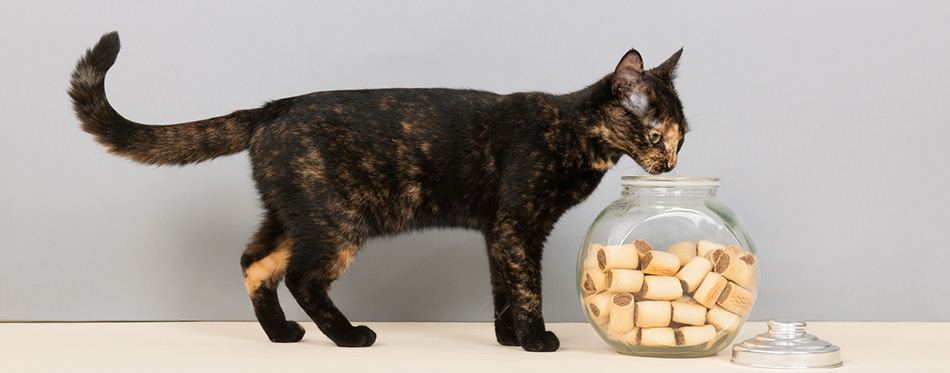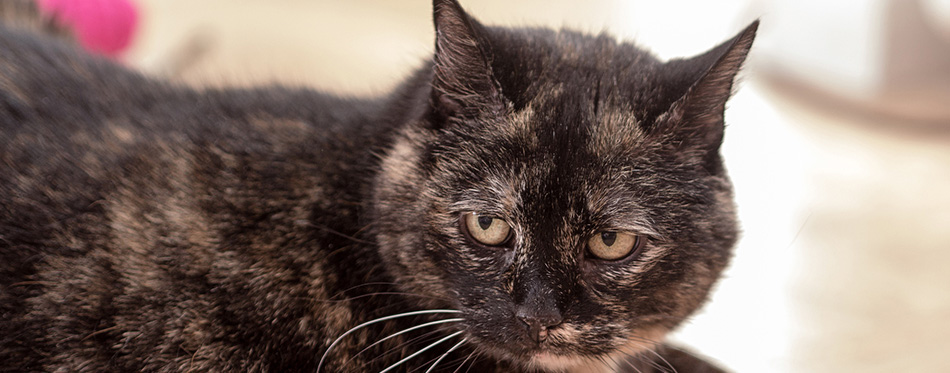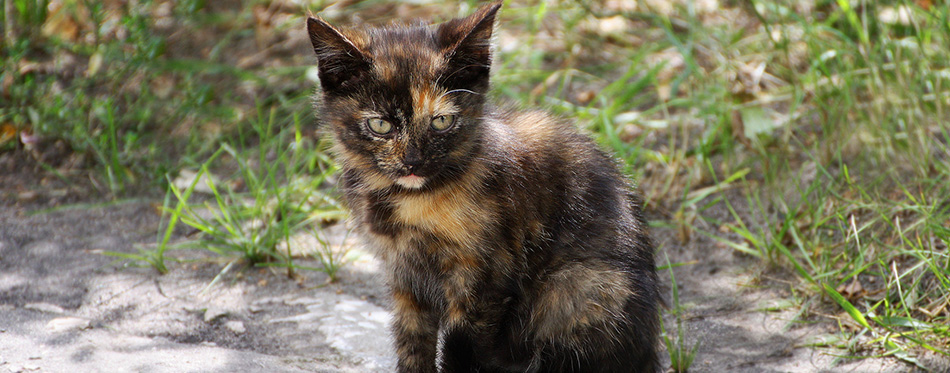Tortoiseshell cats are obviously beautiful and are also affectionately referred to as tortoiseshell for short. The cat’s exceptional multi-color coat hides several amazing facts that will endear any cat fancier to them. Though we believe them to be vocal and sassy, they are also known to be fiercely loyal to their adopters, and their love for family is best described as unconditional. What’s more, the energy level of the tortoiseshell is just endless, which most people describe as a display of stubbornness. But some see this exuberance as an exhibition of extra sensitivity relative to other felines. This abundant energy also underlines the fact that adequate playtime must be provided. Potential cat adopters who are on the lookout for a feline that will keep them on their toes cannot go wrong with a tortoiseshell. Read on to get some important facts about this female-dominated group of cats, including details on health, care, temperament, and much more.

History of Tortoiseshell Cats
There is no specific breed of feline called tortoiseshell cat. The term ‘Tortoiseshell’, came from a mixture of diverse cat coat colors that bear a resemblance to the shell of a tortoise. It is pretty much used to refer to a group of cats sporting distinct multi-colored coats. Traditionally, we expect to see mixtures of black, orange, red, and brown on the fur of a typical tortoiseshell. In fact, genetics has diluted the coloring in some of these cats, giving them a less intense appearance – this category is often referred to as dilute tortoiseshell cats and there are also chocolate tortoiseshell felines sporting darker coats.
Since all tortoiseshell felines are not members of a particular breed, it is rather difficult to trace their history. Each cat comes with its own history according to the breed they came from. We have seen tortoiseshell occurring within the circles of both pure breeds and designer cats. Notable among them are British Shorthair, American Shorthair, Persian Cats, Oriental Shorthair, Burmese, Siamese, American bobtail, and Birman Cat. Others include; Colorpoint Shorthair, Turkish Van Cat, Japanese Bobtail, European Shorthair, Maine Coon, Norwegian Forest Cat, Devon Rex, Cornish Rex, Manx Cat, American curl, and Somali Cat.
Talking about the coat pattern, the most widespread style is the mosaic – this means that the normal color combo will be randomly mixed. Conversely, we also have the chimera pattern, which is a description for a tortoiseshell sporting a distinct color on one half of the body, while the other half is a completely different color. This is usually evident on their faces; however, we have seen situations where the two colors ran throughout the feline’s entire body.
In addition to the chimera and the mosaic patterns, the tortoiseshell coat coloring still extends to include the patched and bridled. The ‘patched’ refers to a coat color occurring in large fragments all over the cat’s body. The patches can be noticed in varying sizes – some occur in large patterned areas while some come in finely speckled markings. On the other hand, bridled refers to those tortoiseshell with colors that have the appearance of being woven together.
Quick Facts About Tortoiseshell Cats
- Tortoiseshell cats are named after the tortoiseshell pattern thanks to the similarity in their coat markings.
- These felines are almost always female; thus, any tortoiseshell you sight is most likely to be a she-cat – this is so because the X chromosome is a carrier of the gene responsible for black or orange coat colors. Naturally having two X chromosomes endows the female with the advantage of getting both black and orange on their coat. The males are left with either of the colors but never both. As a result, this tribe of the tortoiseshell can only ever be dominated by females.
- Male tortoiseshell cats do exist, and it is usually as a result of gene mutation. This kind of case is so rare that it might just be one out of 3,000.
- The male tortoiseshell are particularly sterile and are ridden with so many health problems all through their lives.
- Apart from white, the cat usually combines a couple of colors together. More often than not, the color combos appear as black and red: however, the black color can also be mistaken for chocolate, tabby, grey, or blue, and instead of red, a yellow, orange, or cream color is also common. A good example is a beautiful orange and black cat with the tortoiseshell.
- There are many cats in the tortoiseshell category referred to as torbie – which is another term referring to those tortoiseshell cats sporting a tabby pattern among the colors on their coats.
- Parti-colored cats with comparatively little or no white colors are the typical tortoiseshell cats, while those that are predominantly white, but with the tortoiseshell patches on display, are called tricolors. These markings are evident in both feral and domesticated cats.
- Typically, the patches of colors with more of the white appear to be more solid.It’s worth noting also that this coloring can be modified by diluting the genes, which will lighten the coat color to a mixture of blue, cream, fawn, and lilac. The markings found on the fur of a tortoiseshell is usually as asymmetrical.
- It is not possible to predict the life-span of the tortoiseshell cats since they belong to unrelated breeds – thus, their life expectancy will differ from one cat to another. However, there is this tale of a tortoiseshell called Marzipan that lived up to 21 years and made the records as one of the oldest in that category. Marzipan lived in Melbourne, Australia, where it arrived as a tortoise kitten and passed away in 2013 from a protracted illness.
- We can’t conclude the talk about the tortoiseshell without given a mention to the cat’s alleged tortitude. The tortoiseshell cat personality is often described as feisty. In fact, they are the recognized divas of the feline world thanks to their fiercely independent and strong-willed disposition. However, there is little proof that the tortoiseshell are endowed with more attitude than others.
- The tortoiseshell also feature in a few folklores and myths, especially in Ireland and Scotland, where they view a male tortoiseshell entering a household as a sign of good luck. In the United States, these beautiful cats are called “money cats.” They still went on to make a mark in the Southeast Asian folklore where the Khmers are of the belief that the tortoiseshell emanated from “the blood of a youthful goddess that was the child of a lotus flower.” Other tales include the fishermen of Japanese origin who hold fast to their belief that the presence of a tortoiseshell cat on a boat offers them protection against ghosts and stormy weather.

Things You Should Know About Tortoiseshell Cats
Health
Not all coming from the same breed means that tortoiseshell cats are likely to suffer similar health issues their respective breeds also suffer from. For example, a tortoiseshell belonging to the Burmese breed may get cherry eye, while the Siamese can be expected to show signs of progressive retinal atrophy. However, general feline health issues like obesity and periodontal diseases have been observed in a few tortoiseshell cats. In conclusion, the cats are generally healthy and can live for a very long time, as evidenced in the case of Marzipan that lived beyond 21 years of age.
Recommendations for potential cat parents who wish to adopt a tortoiseshell cat is to ask the breeder for a form of written health guarantee showing that the kitty is free from any inherited health condition.
Feeding
In the same way as every other feline, the tortoiseshell group of cats thrives on a healthy cat’s diet. “Healthy feline diet” is defined as cat food that is replete with all the essential animal-based proteins needed for the growth and development of every cat. However, care should be taken with meals to avoid overfeeding, which will eventually lead to obesity. Recommendations are that you feed your cat two meals per day as opposed to free feeding – one meal in the morning and the next one comes in the evening.
The quantity of kibble to shake into the cat’s bowl will depend on several factors like age, energy level, weight, and health. You cannot feed tortoise kittens and full-grown cats with the same quantity of kibble. Besides, if your cat happens to be an outdoor one, you need to consider the fact that it may be lynching and eating whole prey.
For more guides on choosing the right cat food, you may wish to check out our reviews of the best wet cat food, cat food for constipation, hypoallergenic cat food, cat food for hairballs and cat food for sensitive stomachs.
Care
Caring for the tortoiseshell cat is no different from the care you give to every breed. Hygiene should be taken seriously as cats are very particular about cleanliness; thus, the cat litter box should be cleaned on a regular basis. Always keep your cat indoors to avoid incidents of theft, accident, and attack from bigger animals. Besides, keeping an indoor-only cat will keep your fur buddy from contacting any feline disease that might be making the rounds.
Grooming
As mentioned earlier, several of the known cat breeds have the tortoiseshell occurring among them. Thus, some are long-haired while others are born with short hair. Consequently, grooming for all tortoiseshells cannot follow the same pattern.
For short-haired cats, bathing may not occur as frequently as you would bath a long-haired one. lLikewise, grooming will equally not be as regular, as they are not as prone to matting as their long-haired counterparts – just remember to increase the brushing sessions during the shedding period as this reduces the amount of hair trail that the cat is likely to leave all over the house.
However, brushing of teeth and cleaning of the ears will likely follow the same procedures. Be sure to use toothpaste made exclusively for cats and brush once daily. Pet parents who cannot manage the daily brushing can do it on a weekly basis. Besides, chew toys for cats should be made available as this helps to reduce the amount of tartar that is likely to build up before the next brushing session.
The ears and eyes of your tortoiseshell should be checked on a regular basis – clean with a soft wet cotton cloth or cotton bud when the need arises. What’s more, the corners of the eyes should be equally wiped with a wet cloth to get rid of the discharge from the corners of both eyes. Finally, we are not forgetting the pedicure session for the tortoiseshell, which you should be done when due.
For more help on cat grooming, you may wish to read our guides on the best cat ear cleaners, cat nail clippers, brushes for cats, cat grooming gloves and cat shampoos.

Temperament
It is common knowledge that no two tortoiseshell cats are likely to display exactly the same character trait, except when both come from the same breed. The cat’s personality otherwise referred to as “tortitude” varies from one tortoiseshell to another. In fact, it is a wide array of individuality that defines the temperament of the tortoiseshell cats.
We have seen some tortoiseshell cats that resort to using their parent’s legs as a scratcher after coming over to welcome them home. Whilst some others are the exact opposite of what you would expect from the group – they appear calm, shy, and gentle with a subtle display of stubbornness. There are still some of them that manifest their own tortitude in constant excitement – they just love whatever and whoever comes their way. We also have some that exhibit extreme sensitivity to their environment and waste no time in responding to whatever they encounter as a threat.
All these exceptional personalities are acceptable to fanciers of the tortoiseshell cats; however, not all of them are expected to display every one of these attributes. Nevertheless, the majority do appear to fulfill this reputation, and according to popular belief, tortitude is very real.
Generally, tortoiseshell cats are believed to be extremely opinionated, aloof to some extent, dominant, and go about their business with the mentality they are well above all things. The cat has an unpredictable nature and comes across as strong-willed and independent. Their energy level is quite high, and one positive character of the tortoiseshell cat is that it loves to sit for head rubs and demand some tender loving care from its human family.
Source:
- Tortoiseshell Cats – Town Cats

